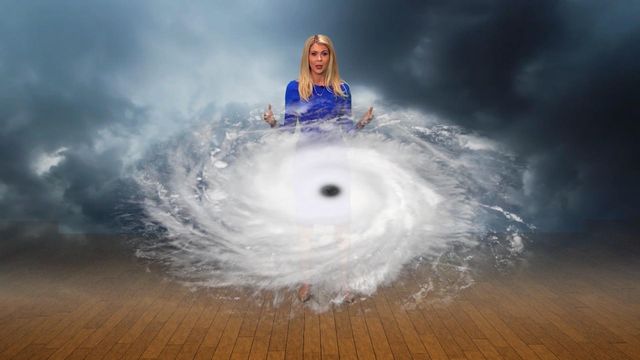From Category 1 to hurricane Category 5 - Here's what you need to know about the Saffir-Simpson Wind Scale
A hurricane is a type of tropical cyclone that forms either in the Atlantic or Pacific ocean, on either side of North America. These storms can range in size from small tropical wind storms to massive hurricanes. There are three steps to categorizing a storm: formation, track and strength. But how are hurricanes categorized?
The five categories of a hurricane | The Saffir-Simpson Wind Scale up to hurricane category 5

The Saffir-Simpson Wind Scale is a 1-5 scale used to measure the intensity of hurricanes. The higher the number, the more intense the hurricane. Hurricanes are rated on this scale based on the following factors: wind speed, storm surge and damage potential. There are five categories of hurricanes that make up the Saffir-Simpson Wind Scale. They are Category 1, Category 2, Category 3, Category 4 and Category 5.
The most dangerous part of a hurricane is its wind field. The larger the storm, the wider its wind field and the greater the potential for damage. A hurricane's wind field also affects its storm surge. The higher the winds, the higher the surge.
Category 1 hurricanes: Winds 74-95 mph, Storm surge 4-5 ft
Category 1 hurricanes are the most common and least dangerous type of hurricane. They are typically small, with winds of 74-95 mph. These storms usually cause minimal damage and little to no loss of life.
Category 1 hurricanes can still be dangerous, however.
The most common damage is to roofs, shingles, vinyl siding and gutters. Branches can snap off trees, and trees with shallow roots, or those in already wet soil, could topple. Power outages are possible if high winds or blowing branches damage power lines.
Category 1 hurricanes are not typically predicted very far in advance, so it is important to always be prepared for them. Make sure you have a plan in place in case of a storm, and stock up on supplies like food, water and flashlights.
Category 2 hurricanes: Winds 96-110 mph, Storm surge 6-8 ft
Category 2 hurricanes are typically more intense than Category 1 storms, but not as severe as Category 3 hurricanes. These storms can cause significant damage, particularly if they make landfall. Category 2 hurricanes are typically those that have wind speeds between 96-110 mph. These storms can cause extensive damage to coastal areas and some inland flooding.
Category 2 hurricanes often result in roof damage, power outages and downed trees.
Category 3 hurricanes: Winds 111-129 mph, Storm surge 9-12 ft
Category 3 hurricanes are considered major storms. Winds can reach up to 129 mph, and they can cause significant damage to coastal areas. High waves and storm surges often accompany these storms. Category 3 hurricanes are capable of causing extensive damage, even to sturdy structures. In addition, they often produce flooding rains that can further damage property and endanger lives.
If you live in an area that could be affected by a major storm, make sure you have a plan in place and are prepared for the worst.
Category 4 hurricanes: Winds 130-156 mph, Storm surge 13-18 ft

Category 4 hurricanes are defined as major storms with 130-156 mph winds. These storms can cause extensive damage, particularly if they make landfall. Roofs can blow off and exterior walls be blown in.
Damage to trees and power outages are often widespread along the path of a Category 4 hurricane, leaving roads impassible and power out for days.
In the Atlantic, there have been a total of 142 Category 4 hurricanes since 1851. The most recent was Hurricane Sam in late 2021, which threatened both Puerto Rico and the Bahamas, but luckily never caused extreme damage. The worst impact was in New Hanover County, North Carolina, where 30 people required rescue from rip currents.
Hurricane Category 5: Winds 157 mph or higher, Storm surge 18 ft or higher
Category 5 hurricanes are the most powerful type of storm on Earth. They can cause catastrophic damage with wind speeds of more than 157 mph. These storms are rare, but when they form they can be incredibly destructive.
In the Atlantic Ocean, there have been only 37 tropical storms that have capped as Category 5s since records began in 1851.
The most recent was Hurricane Dorian in 2019. Dorian is regarded as the worst natural disaster in the history of the Bahamas. It made landfall in the mainland USA in North Carolina as a Category 2 storm.
Other notable Category 5 storms include Hurricane Irma (2017) which caused widespread damage in the Caribbean and Florida, Hurricane Katrina (2005), which caused devastating damage in Louisiana and Mississippi, and Hurricane Hugo (1989), which caused $7 billion in damage in South Carolina.
Category 5 hurricanes can form anywhere in the world, but they are most common in the Pacific Ocean and the North Atlantic Ocean. The deadliest Category 5 hurricane on record was Hurricane Mitch, which killed more than 19,000 people in Central America in 1998.
Hurricane categories save lives

Hurricane categories do save lives. By being aware of the different categories, people can be better prepared for the potential damage a hurricane may cause. It is important to heed the warnings of officials and evacuate when necessary. Taking these precautions can help minimize the loss of life and property during a hurricane.
Related articles:
- Hurricane-proof your NC home: Essential steps to weather the storm
- Homeowners insurance doesn't cover floods: How to protect your home in North Carolina
- Hurricane survival kit: How to keep your family safe when a hurricane hits













